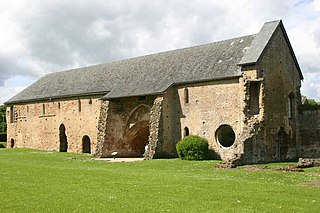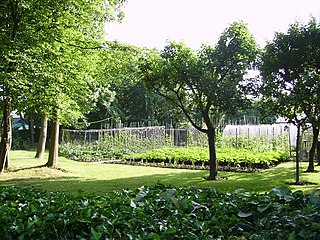Related Research Articles

Fountains Abbey is one of the largest and best preserved ruined Cistercian monasteries in England. It is located approximately 3 miles (5 km) south-west of Ripon in North Yorkshire, near to the village of Aldfield. Founded in 1132, the abbey operated for 407 years, becoming one of the wealthiest monasteries in England until its dissolution, by order of Henry VIII, in 1539.

Dore Abbey is a former Cistercian abbey in the village of Abbey Dore in the Golden Valley, Herefordshire, England. A large part of the original medieval building has been used since the 16th century as the parish church, with remaining parts either now ruined or no longer extant.

Strata Florida Abbey is a former Cistercian abbey situated just outside Pontrhydfendigaid, near Tregaron in the county of Ceredigion, Wales. The abbey was founded in 1164. Strata Florida is a Latinisation of the Welsh Ystrad Fflur; 'Valley of Flowers'; the Welsh word ystrad is synonymous with strath and dale, while fflur ("flower") is also the name of the nearby river. After the region around St Davids was firmly occupied by the Norman Marcher lordship of Pembroke by the early 12th century, with St Davids firmly under Norman influence thereafter, the princely Dinefwr family of Deheubarth transferred their patronage to Strata Florida, and interred many of their family members there.

Rievaulx Abbeyree-VOH was a Cistercian abbey in Rievaulx, situated near Helmsley in the North York Moors National Park, North Yorkshire, England. It was one of the great abbeys in England until it was seized under Henry VIII of England in 1538 during the dissolution of the monasteries. The wider site was awarded Scheduled Ancient Monument status in 1915 and the abbey was brought into the care of the Ministry of Works in 1917. The striking ruins of its main buildings are a tourist attraction, owned and maintained by English Heritage.

Bordesley Abbey was a 12th-century Cistercian abbey near the town of Redditch, in Worcestershire, England.

Vale Royal Abbey is a former medieval abbey and later country house in Whitegate England. The precise location and boundaries of the abbey are difficult to determine in today's landscape. The original building was founded c. 1270 by the Lord Edward, later Edward I for Cistercian monks. Edward had supposedly taken a vow during a rough sea crossing in the 1260s. Civil wars and political upheaval delayed the build until 1272, the year he inherited the throne. The original site at Darnhall was unsatisfactory, so was moved a few miles north to the Delamere Forest. Edward intended the structure to be on a grand scale—had it been completed it would have been the largest Cistercian monastery in the country—but his ambitions were frustrated by recurring financial difficulties.

Cleeve Abbey is a medieval monastery located near the village of Washford, in Somerset, England. It is a Grade I listed building and has been scheduled as an ancient monument.

Whalley Abbey is a former Cistercian abbey in Whalley, Lancashire, England. After the dissolution of the monasteries, the abbey was largely demolished and a country house was built on the site. In the 20th century the house was modified and it is now the Retreat and Conference House of the Diocese of Blackburn of the Church of England. The ruins of the abbey are recorded in the National Heritage List for England as a designated Grade I listed building, and are a Scheduled Ancient Monument.
Stanlow Abbey was a Cistercian abbey situated on Stanlow Point, on the banks of the River Mersey in the Wirral Peninsula, Cheshire, England, near today's Ellesmere Port, 11 km north of Chester Castle and 12 km south-west of Halton Castle.

Combermere Abbey is a former monastery, later a country house, near Burleydam, between Nantwich and Whitchurch in Cheshire, England, near the border with Shropshire. Initially Savigniac and later Cistercian, the abbey was founded in the 1130s by Hugh Malbank, Baron of Nantwich, and was also associated with Ranulf de Gernons, Earl of Chester. The abbey initially flourished, but by 1275 was sufficiently deeply in debt to be removed from the abbot's management. From that date until its dissolution in 1538, it was frequently in royal custody, and acquired a reputation for poor discipline and violent disputes with both lay people and other abbeys. It was the third largest monastic establishment in Cheshire, based on net income in 1535.

Norton Priory is a historic site in Norton, Runcorn, Cheshire, England, comprising the remains of an abbey complex dating from the 12th to 16th centuries, and an 18th-century country house; it is now a museum. The remains are a scheduled ancient monument and are recorded in the National Heritage List for England as a designated Grade I listed building. They are considered to be the most important monastic remains in Cheshire.

Garendon Abbey was a Cistercian abbey located between Shepshed and Loughborough, in Leicestershire, United Kingdom.

Ryd Abbey or Rüde Abbey was a Cistercian monastery in Munkbrarup that formerly occupied the present site of Glücksburg Castle in Glücksburg on the Flensburg Fjord in the Schleswig-Flensburg district of Schleswig-Holstein, Germany.

Poulton is a settlement in Cheshire West and Chester. The area, which was a former civil parish until being merged into the combined parish of Poulton and Pulford in 2015, is in the ceremonial county of Cheshire in England. In 2001 census it had a recorded population of 92.
Hulton Abbey is a scheduled monument in the United Kingdom, a former monastery located in what is now Abbey Hulton, a suburb of Stoke-on-Trent. A daughter house of the Cistercian Combermere Abbey, the abbey was founded by Henry de Audley in the early 13th century. Throughout its life, the abbey was relatively small and poor, with one of the lowest incomes of all Staffordshire religious houses. The abbey was dissolved by Henry VIII in 1538, with its land and assets being sold.

Grace Dieu Abbey was a small Cistercian abbey established in 1226 near to the town of Monmouth in south east Wales. No remains of its buildings can now be seen above ground. It was originally located on the west bank of the River Trothy, in remote countryside about 2 miles (3.2 km) north of the village of Dingestow, but relocated on at least one occasion after being attacked by the Welsh. Its final site is uncertain, but investigations have focused on a field on the east side of the Trothy, at grid reference SO45121311, and this is the location labeled on OS maps.

Maenan Abbey was a monastic religious house located in Maenan, Conwy, Wales. It is situated near Llanrwst.
Poulton Chapel is a ruined mediaeval chapel in the hamlet of Poulton, Cheshire, England, close to the modern border with Wales.
References
- ↑ Historic England. "Monument No. 68788". Research records (formerly PastScape). Retrieved 7 October 2015.
- ↑ Emery, Mike (July 2002). "Poulton: the search for a lost Cistercian abbey". Current Archaeology (180): 520–525.
- ↑ "Poulton Hall, Pulford, Cheshire: Archaeological evaluation and assessment of results" (PDF). Wessex Archaeology on behalf of Videotext Communications Ltd. April 2007. p. 21. Retrieved 23 April 2013.
- ↑ "The Abbey Habit". Time Team. Season 14. 1 April 2007. Channel 4 (UK).
